Cuban Missile Crises (page 2)
Crisis continues
Direct aggression against Cuba would mean nuclear war. The Americans speak about such aggression as if they did not know or did not want to accept this fact. I have no doubt they would lose such a war. —Ernesto "Che" Guevara, October 1962[60]
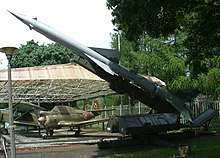
S-75 Dvina with V-750V 1D missile (NATO SA-2 Guideline) on a launcher. An installation similar to this one shot down Major Anderson's U-2 over Cuba.
Castro, on the other hand, was convinced that an invasion of Cuba was soon at hand, and on October 26, he sent a telegram to Khrushchev that appeared to call for a pre-emptive nuclear strike on the USA. However, in a 2010 interview, Castro said of his recommendation for the Soviets to attack America before they made any move against Cuba: "After I've seen what I've seen, and knowing what I know now, it wasn't worth it at all."[61] Castro also ordered all anti-aircraft weapons in Cuba to fire on any US aircraft,[62] whereas in the past they had been ordered only to fire on groups of two or more. At 6:00 am EDT on October 27, the CIA delivered a memo reporting that three of the four missile sites at San Cristobal and the two sites at Sagua la Grande appeared to be fully operational. They also noted that the Cuban military continued to organize for action, although they were under order not to initiate action unless attacked.[citation needed]
At 9:00 am EDT on October 27, Radio Moscow began broadcasting a message from Khrushchev. Contrary to the letter of the night before, the message offered a new trade, that the missiles on Cuba would be removed in exchange for the removal of the Jupiter missiles from Italy and Turkey. At 10:00 am EDT, the executive committee met again to discuss the situation and came to the conclusion that the change in the message was due to internal debate between Khrushchev and other party officials in the Kremlin.[63]:300 McNamara noted that another tanker, the Grozny, was about 600 miles (970 km) out and should be intercepted. He also noted that they had not made the USSR aware of the blockade line and suggested relaying this information to them via U Thant at the United Nations.[64]
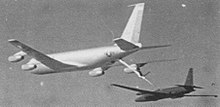
A
Lockheed U-2F, the high altitude reconnaissance type shot down over Cuba, being refueled by a
Boeing KC-135Q. The aircraft in 1962 was painted overall gray and carried USAF military markings and national insignia.
While the meeting progressed, at 11:03 am EDT a new message began to arrive from Khrushchev. The message stated, in part,
You are disturbed over Cuba. You say that this disturbs you because it is ninety-nine miles by sea from the coast of the United States of America. But... you have placed destructive missile weapons, which you call offensive, in Italy and Turkey, literally next to us... I therefore make this proposal: We are willing to remove from Cuba the means which you regard as offensive... Your representatives will make a declaration to the effect that the United States ... will remove its analogous means from Turkey ... and after that, persons entrusted by the United Nations Security Council could inspect on the spot the fulfillment of the pledges made.
The executive committee continued to meet through the day.
Throughout the crisis, Turkey had repeatedly stated that it would be upset if the Jupiter missiles were removed. Italy's Prime Minister Fanfani, who was also Foreign Minister ad interim, offered to allow withdrawal of the missiles deployed in Apulia as a bargaining chip. He gave the message to one of his most trusted friends, Ettore Bernabei, the general manager of RAI-TV, to convey to Arthur M. Schlesinger, Jr.. Bernabei was in New York to attend an international conference on satellite TV broadcasting. Unknown to the Soviets, the US regarded the Jupiter missiles as obsolescent and already supplanted by the Polaris nuclear ballistic submarine missiles.[13]
On the morning of October 27, a U-2F (the third CIA U-2A, modified for air-to-air refueling) piloted by USAF Major Rudolf Anderson,[65] departed its forward operating location at McCoy AFB, Florida. At approximately 12:00 pm EDT, the aircraft was struck by a S-75 Dvina (NATO designation SA-2 Guideline) SAM missile launched from Cuba. The aircraft was shot down and Anderson was killed. The stress in negotiations between the USSR and the US intensified, and only much later was it learned that the decision to fire the missile was made locally by an undetermined Soviet commander acting on his own authority. Later that day, at about 3:41 pm EDT, several US Navy RF-8A Crusader aircraft on low-level photoreconnaissance missions were fired upon.
At 4:00 pm EDT, Kennedy recalled members of EXCOMM to the White House and ordered that a message immediately be sent to U Thant asking the Soviets to "suspend" work on the missiles while negotiations were carried out. During this meeting, General Maxwell Taylor delivered the news that the U-2 had been shot down. Kennedy had earlier claimed he would order an attack on such sites if fired upon, but he decided to not act unless another attack was made. In an interview 40 years later, McNamara said:
We had to send a U-2 over to gain reconnaissance information on whether the Soviet missiles were becoming operational. We believed that if the U-2 was shot down that—the Cubans didn't have capabilities to shoot it down, the Soviets did—we believed if it was shot down, it would be shot down by a Soviet surface-to-air-missile unit, and that it would represent a decision by the Soviets to escalate the conflict. And therefore, before we sent the U-2 out, we agreed that if it was shot down we wouldn't meet, we'd simply attack. It was shot down on Friday [...]. Fortunately, we changed our mind, we thought "Well, it might have been an accident, we won't attack." Later we learned that Khrushchev had reasoned just as we did: we send over the U-2, if it was shot down, he reasoned we would believe it was an intentional escalation. And therefore, he issued orders to Pliyev, the Soviet commander in Cuba, to instruct all of his batteries not to shoot down the U-2.[note 1][66]
Drafting the response
Emissaries sent by both Kennedy and Nikita Khrushchev agreed to meet at the Yenching Palace Chinese restaurant in the Cleveland Park neighborhood of Washington D.C. on the evening of October 27.[67] Kennedy suggested that they take Khrushchev's offer to trade away the missiles. Unknown to most members of the EXCOMM, Robert Kennedy had been meeting with the Soviet Ambassador in Washington to discover whether these intentions were genuine. The EXCOMM was generally against the proposal because it would undermine NATO's authority, and the Turkish government had repeatedly stated it was against any such trade.
As the meeting progressed, a new plan emerged and Kennedy was slowly persuaded. The new plan called for the President to ignore the latest message and instead to return to Khrushchev's earlier one. Kennedy was initially hesitant, feeling that Khrushchev would no longer accept the deal because a new one had been offered, but Llewellyn Thompson argued that he might accept it anyway.[68] White House Special Counsel and Adviser Ted Sorensen and Robert Kennedy left the meeting and returned 45 minutes later with a draft letter to this effect. The President made several changes, had it typed, and sent it.
After the EXCOMM meeting, a smaller meeting continued in the Oval Office. The group argued that the letter should be underscored with an oral message to Ambassador Dobrynin stating that if the missiles were not withdrawn, military action would be used to remove them. Dean Rusk added one proviso, that no part of the language of the deal would mention Turkey, but there would be an understanding that the missiles would be removed "voluntarily" in the immediate aftermath. The President agreed, and the message was sent.
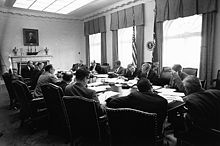
An
EXCOMM meeting on October 29, 1962 held in the White House Cabinet Room during the Cuban missile crisis. President Kennedy is to the left of the American flag; on his left is Secretary of Defense
Robert McNamara and his right is Secretary of State
Dean Rusk.
At Juan Brito[specify]'s request, Fomin and Scali met again. Scali asked why the two letters from Khrushchev were so different, and Fomin claimed it was because of "poor communications". Scali replied that the claim was not credible and shouted that he thought it was a "stinking double cross". He went on to claim that an invasion was only hours away, at which point Fomin stated that a response to the US message was expected from Khrushchev shortly, and he urged Scali to tell the State Department that no treachery was intended. Scali said that he did not think anyone would believe him, but he agreed to deliver the message. The two went their separate ways, and Scali immediately typed out a memo for the EXCOMM.[citation needed]
Within the US establishment, it was well understood that ignoring the second offer and returning to the first put Khrushchev in a terrible position. Military preparations continued, and all active duty Air Force personnel were recalled to their bases for possible action. Robert Kennedy later recalled the mood, "We had not abandoned all hope, but what hope there was now rested with Khrushchev's revising his course within the next few hours. It was a hope, not an expectation. The expectation was military confrontation by Tuesday, and possibly tomorrow...".[citation needed]
At 8:05 pm EDT, the letter drafted earlier in the day was delivered. The message read, "As I read your letter, the key elements of your proposals—which seem generally acceptable as I understand them—are as follows: 1) You would agree to remove these weapons systems from Cuba under appropriate United Nations observation and supervision; and undertake, with suitable safe-guards, to halt the further introduction of such weapon systems into Cuba. 2) We, on our part, would agree—upon the establishment of adequate arrangements through the United Nations, to ensure the carrying out and continuation of these commitments (a) to remove promptly the quarantine measures now in effect and (b) to give assurances against the invasion of Cuba." The letter was also released directly to the press to ensure it could not be "delayed".[citation needed]
With the letter delivered, a deal was on the table. However, as Robert Kennedy noted, there was little expectation it would be accepted. At 9:00 pm EDT, the EXCOMM met again to review the actions for the following day. Plans were drawn up for air strikes on the missile sites as well as other economic targets, notably petroleum storage. McNamara stated that they had to "have two things ready: a government for Cuba, because we're going to need one; and secondly, plans for how to respond to the Soviet Union in Europe, because sure as hell they're going to do something there".[citation needed]
At 12:12 am EDT, on October 27, the US informed its NATO allies that "the situation is growing shorter... the United States may find it necessary within a very short time in its interest and that of its fellow nations in the Western Hemisphere to take whatever military action may be necessary." To add to the concern, at 6 am the CIA reported that all missiles in Cuba were ready for action.
Later on that same day, what the White House later called "Black Saturday", the US Navy dropped a series of "signaling depth charges" (practice depth charges the size of hand grenades[69]) on a Soviet submarine (B-59) at the blockade line, unaware that it was armed with a nuclear-tipped torpedo with orders that allowed it to be used if the submarine was "hulled" (a hole in the hull from depth charges or surface fire).[70] The decision to launch these required agreement from all three officers on board, but one of them, Vasili Arkhipov, objected and so the launch was narrowly averted.
On the same day a US U-2 spy plane made an accidental, unauthorized ninety-minute overflight of the Soviet Union's far eastern coast.[71] The Soviets responded by scrambling MiG fighters from Wrangel Island; in turn the Americans launched F-102 fighters armed with nuclear air-to-air missiles over the Bering Sea.[72]
On October 27, Khrushchev also received a letter from Castro – what is now known as the Armageddon Letter (dated Oct. 26) – interpreted as urging the use of nuclear force in the event of an attack on Cuba.[73] "I believe the imperialists' aggressiveness is extremely dangerous and if they actually carry out the brutal act of invading Cuba in violation of international law and morality, that would be the moment to eliminate such danger forever through an act of clear legitimate defense, however harsh and terrible the solution would be," Castro wrote.[74]
Crisis ends
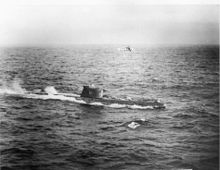
A US Navy
HSS-1 Seabat helicopter hovers over Soviet submarine
B-59, forced to the surface by US Naval forces in the Caribbean near Cuba (October 28–29, 1962)
On October 27, after much deliberation between the Soviet Union and Kennedy's cabinet, Kennedy secretly agreed to remove all missiles set in southern Italy and in Turkey, the latter on the border of the Soviet Union, in exchange for Khrushchev removing all missiles in Cuba.[75]
At 9:00 am EDT, on October 28, a new message from Khrushchev was broadcast on Radio Moscow. Khrushchev stated that, "the Soviet government, in addition to previously issued instructions on the cessation of further work at the building sites for the weapons, has issued a new order on the dismantling of the weapons which you describe as 'offensive' and their crating and return to the Soviet Union."
Kennedy immediately responded, issuing a statement calling the letter "an important and constructive contribution to peace". He continued this with a formal letter:
I consider my letter to you of October twenty-seventh and your reply of today as firm undertakings on the part of both our governments which should be promptly carried out... The US will make a statement in the framework of the Security Council in reference to Cuba as follows: it will declare that the United States of America will respect the inviolability of Cuban borders, its sovereignty, that it take the pledge not to interfere in internal affairs, not to intrude themselves and not to permit our territory to be used as a bridgehead for the invasion of Cuba, and will restrain those who would plan to carry an aggression against Cuba, either from US territory or from the territory of other countries neighboring to Cuba.
[76]:103
Kennedy's planned statement would also contain suggestions he had received from his adviser, Arthur M. Schlesinger, Jr., in a "Memorandum for the President" describing the "Post Mortem on Cuba."[77]
The US continued the blockade, and in the following days, aerial reconnaissance proved that the Soviets were making progress in removing the missile systems. The 42 missiles and their support equipment were loaded onto eight Soviet ships. The ships left Cuba from November 5–9. The US made a final visual check as each of the ships passed the blockade line. Further diplomatic efforts were required to remove the Soviet IL-28 bombers, and they were loaded on three Soviet ships on December 5 and 6. Concurrent with the Soviet commitment on the IL-28's, the US Government announced the end of the blockade effective at 6:45 pm EDT on November 20, 1962.[41]
At the time when the Kennedy administration thought that the Cuban Missile Crisis was resolved, nuclear tactical rockets stayed in Cuba since they were not part of the Kennedy-Khrushchev understandings. However, the Soviets changed their minds, fearing possible future Cuban militant steps, and at November 22, 1962 the Soviet Deputy Prime Minister Anastas Mikoyan told Castro that those rockets with the nuclear warheads, were being removed too.[18]
In his negotiations with the Soviet Ambassador Anatoly Dobrynin, US Attorney General Robert Kennedy informally proposed that the Jupiter missiles in Turkey would be removed "within a short time after this crisis was over."[78]:222 The last US missiles were disassembled by April 24, 1963, and were flown out of Turkey soon after.[79]
The practical effect of this Kennedy-Khrushchev Pact was that it effectively strengthened Castro's position in Cuba, guaranteeing that the US would not invade Cuba. It is possible that Khrushchev only placed the missiles in Cuba to get Kennedy to remove the missiles from Italy and Turkey and that the Soviets had no intention of resorting to nuclear war if they were out-gunned by the Americans.[80] Because the withdrawal of the Jupiter missiles from NATO bases in Southern Italy and Turkey was not made public at the time, Khrushchev appeared to have lost the conflict and become weakened. The perception was that Kennedy had won the contest between the superpowers and Khrushchev had been humiliated. This is not entirely the case as both Kennedy and Khrushchev took every step to avoid full conflict despite the pressures of their governments. Khrushchev held power for another two years.[76]:102–105
Aftermath
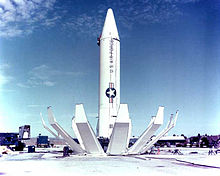
The nuclear-armed
Jupiter intermediate-range ballistic missile. The US secretly agreed to withdraw these missiles from Italy and Turkey.
The compromise embarrassed Khrushchev and the Soviet Union because the withdrawal of US missiles from Italy and Turkey was a secret deal between Kennedy and Khrushchev. The Soviets were seen as retreating from circumstances that they had started. Khrushchev's fall from power two years later was in part because of the Politburo embarrassment at both Khrushchev's eventual concessions to the US and his ineptitude in precipitating the crisis in the first place. According to Dobrynin, the top Soviet leadership took the Cuban outcome as "a blow to its prestige bordering on humiliation".[81]
Cuba perceived the outcome as a partial betrayal by the Soviets, given that decisions on how to resolve the crisis had been made exclusively by Kennedy and Khrushchev. Castro was especially upset that certain issues of interest to Cuba, such as the status of the US Naval Base in Guantánamo, were not addressed. This caused Cuban-Soviet relations to deteriorate for years to come.[82]:278 On the other hand, Cuba continued to be protected from invasion.
Although General Curtis LeMay told the President that he considered the resolution of the Cuban missile crisis the "greatest defeat in our history", his was a minority position.[1]:335 He had pressed for an immediate invasion of Cuba as soon as the crisis began, and still favored invading Cuba even after the Soviets had withdrawn their missiles.[83] 25 years later, LeMay still believed that "We could have gotten not only the missiles out of Cuba, we could have gotten the Communists out of Cuba at that time".[55]
After the crisis the United States and the Soviet Union created the Moscow–Washington hotline, a direct communications link between Moscow and Washington, D.C. The purpose was to have a way that the leaders of the two Cold War countries could communicate directly to solve such a crisis. The world-wide US Forces DEFCON 3 status was returned to DEFCON 4 on November 20, 1962. U-2 pilot Major Anderson's body was returned to the United States and he was buried with full military honors in South Carolina. He was the first recipient of the newly created Air Force Cross, which was awarded posthumously.
Although Anderson was the only combatant fatality during the crisis, 11 crew members of three reconnaissance Boeing RB-47 Stratojets of the 55th Strategic Reconnaissance Wing were also killed in crashes during the period between September 27 and November 11, 1962.[84] Further, seven crew died when a MATS Boeing C-135B Stratolifter delivering ammunition to Guantanamo Bay Naval Base stalled and crashed on approach on October 23.[85]
Critics including Seymour Melman[86] and Seymour Hersh[87] suggested that the Cuban missile crisis encouraged US use of military means, such as in the Vietnam War. This Soviet-American confrontation was synchronous with the Sino-Indian War, dating from the US's military blockade of Cuba; historians[who?] speculate that the Chinese attack against India for disputed land was meant to coincide with the Cuban missile crisis.[88]
Post-crisis revelations
Arthur M. Schlesinger, Jr., a historian and adviser to John F. Kennedy, told National Public Radio in an interview on October 16, 2002 that Castro did not want the missiles, but that Khrushchev had pressured Castro to accept them. Castro was not completely happy with the idea but the Cuban National Directorate of the Revolution accepted them to protect Cuba against US attack, and to aid its ally, the Soviet Union.[82]:272 Schlesinger believed that when the missiles were withdrawn, Castro was angrier with Khrushchev than he was with Kennedy because Khrushchev had not consulted Castro before deciding to remove them.[note 2]
In early 1992, it was confirmed that Soviet forces in Cuba had, by the time the crisis broke, received tactical nuclear warheads for their artillery rockets and Il-28 bombers.[89] Castro stated that he would have recommended their use if the US invaded despite knowing Cuba would be destroyed.[89]
Arguably the most dangerous moment in the crisis was only recognized during the Cuban Missile Crisis Havana conference in October 2002. Attended by many of the veterans of the crisis, they all learned that on October 27, 1962 the USS Beale had tracked and dropped signaling depth charges (the size of hand grenades) on the B-59, a Soviet Project 641 (NATO designation Foxtrot) submarine which, unknown to the US, was armed with a 15 kiloton nuclear torpedo. Running out of air, the Soviet submarine was surrounded by American warships and desperately needed to surface. An argument broke out among three officers on the B-59, including submarine captain Valentin Savitsky, political officer Ivan Semonovich Maslennikov, and Deputy brigade commander Captain 2nd rank (US Navy Commander rank equivalent) Vasili Arkhipov. An exhausted Savitsky became furious and ordered that the nuclear torpedo on board be made combat ready. Accounts differ about whether Commander Arkhipov convinced Savitsky not to make the attack, or whether Savitsky himself finally concluded that the only reasonable choice left open to him was to come to the surface.[90]:303, 317 During the conference Robert McNamara stated that nuclear war had come much closer than people had thought. Thomas Blanton, director of the National Security Archive, said, "A guy called Vasili Arkhipov saved the world."
Fifty years after the crisis, Graham Allison wrote:
Fifty years ago, the Cuban missile crisis brought the world to the brink of nuclear disaster. During the standoff, U.S. President John F. Kennedy thought the chance of escalation to war was "between 1 in 3 and even," and what we have learned in later decades has done nothing to lengthen those odds. We now know, for example, that in addition to nuclear-armed ballistic missiles, the Soviet Union had deployed 100 tactical nuclear weapons to Cuba, and the local Soviet commander there could have launched these weapons without additional codes or commands from Moscow. The U.S. air strike and invasion that were scheduled for the third week of the confrontation would likely have triggered a nuclear response against American ships and troops, and perhaps even Miami. The resulting war might have led to the deaths of 100 million Americans and over 100 million Russians.
[91][92]
BBC journalist Joe Matthews published on October 13, 2012 the story behind the 100 tactical nuclear warheads mentioned by Graham Allison in the excerpt above.[93] Khrushchev feared that Castro's hurt pride and widespread Cuban indignation over the concessions he had made to Kennedy might lead to a breakdown of the agreement between the Soviet Union and the United States. In order to prevent this Khrushchev decided to make Cuba a special offer. The offer was to give Cuba more than 100 tactical nuclear weapons that had been shipped to Cuba along with the long-range missiles, but which crucially had passed completely under the radar of US intelligence. Khrushchev concluded that because the Americans hadn't listed the missiles on their list of demands, the Soviet Union's interests would be well served by keeping them in Cuba.[93]
Anastas Mikoyan was tasked with the negotiations with Castro over the missile transfer deal designed to prevent a breakdown in the relations between Cuba and the Soviet Union. While in Havana, Mikoyan witnessed the mood swings and paranoia of Castro, who was convinced that Moscow had made the agreement with the United States at the expense of Cuba's defense. Mikoyan, on his own initiative, decided that Castro and his military not be given control of weapons with an explosive force equal to 100 Hiroshima-sized bombs under any circumstances. He defused the seemingly intractable situation, which risked re-escalating the crisis, on November 22, 1962. During a tense, four-hour meeting, Mikoyan convinced Castro that despite Moscow's desire to help, it would be in breach of an unpublished Soviet law (which didn't actually exist) to transfer the missiles permanently into Cuban hands and provide them with an independent nuclear deterrent. Castro was forced to give way and - much to the relief of Khrushchev and the whole Soviet government - the tactical nuclear weapons were crated and returned by sea to the Soviet Union during December 1962.[93]
See also
Media
(Listed chronologically)
-
Thirteen Days, Robert F. Kennedy's account of the crisis, released in 1969
-
The Missiles of October, 1974 TV docudrama about the crisis
-
The World Next Door, 1990 novel by Brad Ferguson, set in this period
-
Quantum Leap,1991 TV Show, (Season 3 Episode, Nuclear Family - October 26, 1962), Sam must deal with the panic associated with the Cuban missile crisis as a Florida fallout shelter salesman.
-
Matinee, 1993 film set in Key West, Florida during the Cuban Missile Crisis
-
The short film Symposium on Intelligence and the Cuban Missile Crisis 1962 is available for free download at the Internet Archive [more]
-
seaQuest 2032, 1995 TV Show, (Season 3 Episode, "Second Chance"), seaQuest inadvertently travels back to 1962 where their presence accidentally interferes with the Cuban missile crisis
-
Blast from the Past (film), 1999 American romantic comedy film, set in this period
-
Resurrection Day, 1999 alternate history novel written by Brendan DuBois, set in this period
-
Thirteen Days (film), 2000 docudrama directed by Roger Donaldson about the crisis
-
The Fog of War, 2003 American documentary film about the life and times of former US Secretary of Defense Robert S. McNamara directed by Errol Morris, which won that years' Academy Award for Best Documentary Feature.
-
Metal Gear Solid 3: Snake Eater, 2004 video game directed by Hideo Kojima, features a fictional conflict inspired by the Cuban missile crisis
-
"Meditations in an Emergency", the last episode of season 2 of the television series Mad Men takes place during the crisis
-
Ur (novella), a 2009 short novel by Stephen King released for the Amazon Kindle, is about three men who discover through a magic Kindle that in another "Ur", the Cuban missile crisis escalated into a nuclear war and ended that "Ur".
-
Call of Duty: Black Ops, 2010 video game, set during and after the Cuban missile crisis.
-
The Kennedys (TV miniseries), 2011 production chronicling the lives of the Kennedy family, including a dramatization of the crisis
-
X-Men: First Class, 2011 superhero film set during the Cuban missile crisis
-
The Armageddon Letters, a transmedia storytelling of the crisis with animated short films and other digital content
-
"Cuban Missile Crisis: The Man Who Saved the World", Secrets of the Dead, PBS TV documentary, October 24, 2012
| Author: | Bling King |
| Published: | Mar 23rd 2013 |
| Modified: | Mar 23rd 2013 |